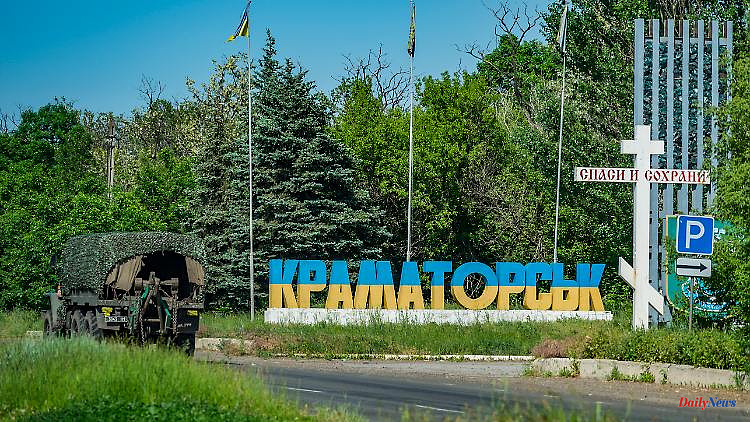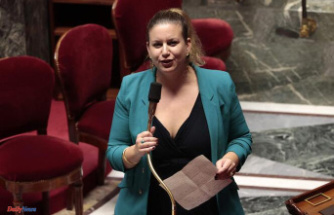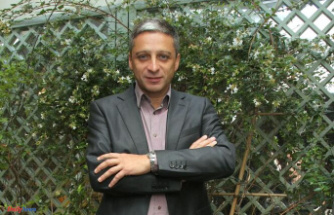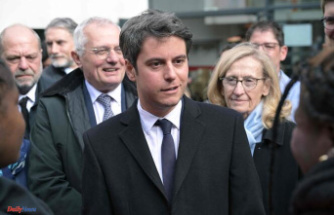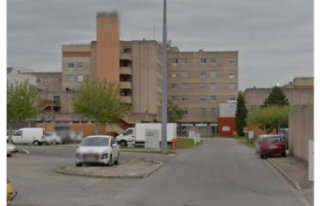At the beginning of the war, the Ukrainian army acted very wisely, says military historian and colonel in the Austrian army, Markus Reisner. "The Russians recognized that and adjusted to it." In the ongoing battle in the Donbas pocket, he sees the chances being unequally distributed.
"If something surprising does not happen on the battlefield that none of us knew about, if there are not massive Ukrainian counterattacks, if there are not sudden swarms of kamikaze drones or a hundred multiple rocket launchers from the United States, then Russia will fight this battle in Donbass on the decide the timeline for yourself." The now announced delivery of multiple rocket launchers by the USA will not have a quick effect, says Colonel Reisner. "Four throwers, that has no influence at all, that's purely symbolic."
Reisner is head of the research and development department at the Theresian Military Academy in Wiener Neustadt. He regularly publishes films on YouTube in which he explains the course of the war.
ntv.de: In the Donbass, the fighting is currently concentrated in a pocket around the cities of Kramatorsk and Slowjansk. How is the military situation there?
Markus Reisner: Overall, the pocket is 40 by 40 kilometers in size - the Russians are still 20 kilometers away from completely enclosing the area. In those 20 kilometers northwest of Popasna, there is currently fierce fighting over the southern of two roads leading into the pocket, the T1302. This traffic connection is hardly usable for the Ukrainians because the Russians already have them under control by fire: the Russians shoot at every movement on the street. There are pictures of wrecks lining the road to the left and right. Through this connection, the Ukrainians can no longer get any more forces or weapons into the boiler - in the worst case, no more forces out either. Everything is now concentrated on the north road, the T0513.
If Ukraine cannot hold the pocket east of Sloviansk and Kramatorsk anyway, would it not be better, from a military point of view, to abandon the area and move the defensive line further west?
It is not known whether there is a hold order telling the Ukrainians to stay in the pocket. However, there are already some videos showing Ukrainian soldiers going back, either on orders or on their own. However, this can set off a chain reaction. According to the official account, the war is going well despite all the problems, although President Zelenskyy has now said that Ukraine has suffered heavy losses.
He spoke of up to 100 killed Ukrainian soldiers a day.
In addition, there is at least twice the number of wounded. Selenskyj even spoke of up to 500 wounded. If you extrapolate that, that's 3,000 dead and 6,000 wounded in one month. That's an enormous number. The medical supply is precarious. In the hospitals of Bakhmut, Sloviansk and Kramatorsk, only amputations are done anymore, there is no more reconstructive surgery. It's all about survival. Most soldiers die at the front or on the way to the hospitals.
You spoke of a chain reaction that could develop on the Ukrainian side.
The danger is that general panic will break out in the pocket and the soldiers will try to retreat to a favorable line that is easier to hold. If this is done in an orderly manner, that would be a line east of Sloviansk and Kramatorsk. But if panic breaks out, that last line could be much lower, on the Dnipro.
Then practically half of Ukraine would be lost.
The Russians currently occupy 24 percent of Ukraine - less than they already had, but a lot. Before February 24, 80 percent of the country's value creation took place in these 24 percent. The Russians have captured 95 percent of the Kherson district, about 70 percent of the neighboring Zaporizhia district, 60 percent of Donetsk, and 97 percent of Luhansk.
By the way, there are two interesting comparisons from history to the Donbas pocket, both of which have a German connection. One is the heavy fighting around Verdun in the First World War. The German General Erich von Falkenhayn wanted to turn Verdun into a "meat grinder" for the French, he wanted to beat them there in a war of attrition. He would have almost succeeded if the Allies had not come to the French's aid. It could be that the Russian tactic is to use up as many incoming Ukrainian arms and troops as possible in the Donbas pocket.
And the other potential parallel?
This is the Falaise cauldron, 1944 in France. This battle broke the neck of the German Wehrmacht in France. They waited too long, were surrounded, panic broke out, the Germans had to retreat and were only able to form a continuous front line again on the German-French border. If Ukraine hesitates too long in Donbass and there is no reliable chance of winning this battle, such a chain reaction may set in.
Why was Ukraine so successful at the beginning of the war?
In March, the director of US Defense Intelligence, General Scott Berrier, told a congressional committee that he had never seen the US share so much intelligence with another country in his 35-year career. That was one of three main factors that helped Ukraine. The second factor, of course, was the supply of light arms, and the third factor was the tactics of the Ukrainians: letting the enemy in and then attacking their supply lines in depth. The Ukrainians acted very cleverly, and light weapons were perfect for that.
But?
The Russians recognized this and adjusted to it. In the seventh week of the war, there was a change in strategy. The Russians claim today that that was always their plan, that they never wanted to take Kyiv, that the attack was just a distraction. Of course that's not true. For example, the Russians' repeated attempts to advance across the Irpin River towards Kyiv: if this had been a purely diversionary or tie-down attack, it would not have been carried out with such intensity. The Russians' original plan was quite obvious to carry out some sort of coup d'état: they wanted to place Russian paratroopers on the Maidan, they wanted to behead the political and military leadership. To do this, they didn't want to conquer the whole city first, but wanted to push straight into the city center. We also know this because the Russians specifically sent messages from drones to the cellphones of Ukrainian soldiers, saying that the Ukrainian government had fallen and that further fighting was hopeless.
And since the seventh week...?
Since then, the Russian army has concentrated on the Donbass. In less than ten days, Russian forces were transferred from northern Ukraine to the east. It was a logistical masterpiece. The leadership of the war was then placed in one hand, under the command of General Alexander Dvornikov. He decided that the attack would no longer be fast, narrow and deep, but according to the old Soviet military doctrine: every attack should be massively prepared with artillery. We in the West have no idea what that means. It's not just about the typical artillery shells, it's rocket artillery - for example with the BM-27, the Uragan. This system destroys everything in a 900 by 900 meter square. It started in April, and since then the Ukrainians have been under massive artillery fire on the Donbass front.
So was the cauldron prepared?
First, the Russians tried to cross the Donets River in the north, so the Ukrainians had to redeploy forces there. With that, they exposed the South. There, near Popasna, their defenses have cracked, and the Russians made a breakthrough there at the beginning of May. The Russians are now firing into the pocket from three sides.
Can the supplies that have now been promised by the USA have a decisive influence on the war, for example the HIMARS type multiple rocket launcher systems?
Only after long discussions did the USA decide to deliver four such multiple rocket launchers. But Ukraine would need at least 100 rocket launchers of this type to have an effect soon. Four throwers, that has no influence at all, that's purely symbolic. You can't even support a regionally limited offensive with that. Overall, I can't help but get the impression that the current arms shipments are not only late, but far too small. From German military history there is a saying: "don't spill, but big". In order to defend itself effectively, Ukraine would have to massively join forces. A few howitzers here and there won't be enough.
In your most recent video, you presented Ukrainian films from social networks to show that the morale of the Ukrainian troops is now also suffering.
There are now 15 videos in which Ukrainian fighters say they can't take it anymore.
Do you also have any indication of bad mood among the Russian troops?
Not by the regular Russian troops, only by auxiliary troops from the so-called People's Republics of Donetsk (DPR) and Luhansk (LPR). Only two videos have surfaced so far. However, they are not professional soldiers either. The Russians consider them "cannon fodder". They are often sent into battle as the first wave. These troops, for example from Luhansk, now consider their task over after the capture of Luhansk Oblast. You don't want to keep fighting. In the Kharkiv area, this was one of the reasons for the retreat of the LPR troops deployed there.
It may be that the Russian troops were embittered by initial setbacks, but any embitterment is replaced by success. The first success was the capture of Mariupol. This gave the Russian troops a boost in morale. If they now also take the Donbass basin, they will have a second success. Of course, this is far from comparable to what they actually planned to do. The kettle was actually planned to be much larger - they wanted to cut off the entire Donbass and now only have a corner of it. But that, too, is expanded propaganda.
It is often said that there is still no Russian air sovereignty in Ukraine.
That's right, they don't. Air supremacy would mean they take no casualties in their airstrikes. These losses are there and they are painful, but they are normal considering the intensity of the operation. However, the Russians have air superiority. This means they can attack targets anywhere in Ukraine with cruise missiles and tactical missiles. For weeks we have seen targeted air strikes against fuel depots, against barracks, against infrastructure objects.
Do you perceive that Russia is heading towards a shortage of materials or personnel?
This is repeatedly claimed, but I don't see it at all. In the third week it was said that Russia had already fired 350 cruise missiles, as many as the Allies did in Iraq in 2003 - it must have been slow. In the meantime, more than 2250 cruise missiles fired have been counted. The Ukrainian general staff itself says that this is now 60 percent of the arsenal. A clear filing for the first evaluation. True, their aiming accuracy is not as high as that of more modern western cruise missiles, but nevertheless there are several burning objects every night in Ukraine. This is of course fatal. Along with the immediate battles in the Donbass pocket, this is the second level of attrition. The Ukrainians can only counteract this wear and tear if they add additional material.
This means?
If something surprising doesn't happen on the battlefield that we all didn't know about, if there weren't massive Ukrainian counterattacks, swarms of kamikaze drones didn't suddenly appear, or a hundred multiple rocket launchers from the United States, then Russia would be this battle in Donbass on the timeline decide for yourself.
How is this continuing?
Unless the Ukrainians have effective military capabilities to counter Russian artillery, the Russians will have gradually taken Donbass by late summer or autumn. After this success, the Russians could say that they had liberated the "People's Republics" - because in the Russian understanding, these two separatist areas had a claim to the entire districts of Donetsk and Luhansk - and that they were now "mercifully" ready to negotiate, although in reality they might no longer have the strength to fight or need time to consolidate and refresh.
The Ukrainian side, on the other hand, could say: Victory is ours, but we will not achieve our maximum demands on the battlefield or through negotiations; we prefer a spring offensive. Both sides would then use the winter to reposition themselves. The decisive factor for the Ukrainians will then be whether they get enough support from the West in the winter. You also have to get millions of people through the winter at the same time. In the winter at the latest, therefore, there will have to be an oath of disclosure in western, and especially in European, politics. Namely on the question of whether or not you are ready to give massive support to Ukraine.
The procedure will depend essentially on the outcome of the economic war that has been waged up to that point. And the question here is not whether our western sanctions will harm Russia, but rather whether our economic systems can cope with the loss of raw material supplies from Russia or not. The yardstick will be the mood and the personal burden in the European population, for example through inflation or rising prices. It starts again in the spring. The Russians could then try to advance from Cherson, where they have a bridgehead on the other bank of the Dnieper, towards Odessa in order to cut off the Ukraine from the Black Sea after all.
Is that still the goal of the Russians?
If things go well, definitely. In the history of war, it has always been the case that objectives are adjusted as the war progresses. If there are setbacks, the goals become smaller. If there are successes, they are increased again.
What will be left of Donbass once the war is over?
Look at the pictures on the Ukrainian and Russian social networks, the drone shots of the localities there. If these pictures were black and white, you would say this is Berlin in 1945. Where there is fighting, no stone is left unturned. The problem is also: The population is partly trapped in the besieged cities. It is assumed that of the 100,000 inhabitants of Sieverodonetsk, 10,000 people are still in the city: the sick, the old, the infirm, people who didn't want to or couldn't leave. It was even worse in Mariupol, where many residents did not have time to flee. I don't even want to know how many thousands of bodies are lying under the rubble there.
Hubertus Volmer spoke to Colonel Markus Reisner

